Abstract
The IEEE 802.15.4-2015 standard defines a number of Medium Access Control (MAC) layer protocols for low power wireless communications, which are desirable for energy-constrained Internet of Things (IoT) devices. Originally defined in the IEEE 802.15.4e amendment, the Time Slotted Channel Hopping (TSCH) has recently been attracting attention from the research community due to its reduced contention (time scheduling) and robustness against fading (channel hopping). However, it requires a certain level of synchronization between the nodes, which can increase the energy consumption. In this work, we implement the Guard Beacon (GB) strategy, aiming at reducing the guard time usually implemented to compensate for imperfect synchronization. Moreover, besides presenting a realistic energy consumption model for a Contiki Operating System-based TSCH network, we show through analytical and practical results that, without the proposed scheme, the power consumption can be more than 13% higher.
1. Introduction
Energy efficiency is a mandatory requirement in the scope of Wireless Sensor Networks (WSNs), since these kind of networks are usually composed of battery-powered devices, whose batteries are not always easily replaceable [1,2]. For instance, one can mention either the lack of natural and economic resources or the harsh environments where many of such WSNs are placed as impairments for battery replacement [3]. Thus, it becomes of fundamental importance to spend efforts towards reducing the network energy consumption, extending its lifetime as much as possible [2].
The power consumption of massive Internet of Things (IoT) hardware is mainly attributed to the Microcontroller Unit (MCU) and to the transmitter/receiver chains. Many of the existing low-power radio transceivers typically operate with ~30 when in the listening mode, with a slight consumption increase when transmitting. However, regardless of the operating mode, the transceiver-related consumption turns out to be much higher than the MCU consumption [4]. Moreover, the software implementation is usually optimized to keep the MCU sleeping when it is not required. However, low-power radios require energy-concerned Medium Access Control (MAC) protocols. Traditional MAC protocols, such as Carrier Sense Multiple Access (CSMA), require uninterrupted channel sensing and are consequently not suitable for energy-constrained devices, being capable of completely draining the devices’ battery in a matter of days if not associated with Radio Duty Cycling (RDC) mechanisms [5].
The Time Slotted Channel Hopping (TSCH) scheme [6] reduces consumption by applying a time-scheduling approach that allows the nodes to awake only when necessary. However, it requires a certain level of synchronization between the nodes in order to avoid communication outages, since it is critical to guarantee that the packets arrive at the receiver when not in sleep mode. One alternative to mitigate imperfect synchronization-related issues is by adopting a guard time. Moreover, synchronization deteriorates over time due to clock drift, such that there is a need to periodically resynchronize the nodes [7]. Different approaches are adopted in synchronized MAC protocols to address the synchronization problem, such as increasing the Enhanced Beacon (EB) rate [8] or setting a larger guard time for the receiver [9]. Nevertheless, such approaches require either more message exchange or a higher RDC, thus increasing the energy consumption.
In [10] it was shown that the idle listening during the guard time is responsible for most of the overall energy consumption. In [11,12,13], the authors performed empirical optimizations on the guard time in order to maximize the energy efficiency in both single-hop and multi-hop TSCH Network, by adapting the guard time at each node according to its distance to the sink and a target packet delivery ratio. However, the authors rely on very small values for the EB Interval (), which has the drawback of increasing the network traffic and being less energy efficient.
In [8,14], the authors propose a new beacon advertising approach for a fast synchronization. More specifically, although the scheme in [8] achieves faster joining times, the energy consumption is compromised in the initial deployment stage. Later, the same authors present in [14] a scheme that dynamically modifies the transmission period of the Enhanced Beacons, which can be properly adapted to reduce the power consumption and improve connection time and connection success rate. In [15], the existence of collisions between EBs is taken into account, and a novel autonomous EB scheduling method that eliminates collisions is proposed.
In [16] the authors propose an approach where the node proceeds with the re-synchronization by considering multiple routing parents from the IPv6 Routing Protocol for Low Power and Lossy Networks (RPL) as time source. The results suggest that, with two time sources, the network is able to maintain synchronization with smaller guard times, since the maximum synchronization error is contained. However, the authors consider very small values for the EB Interval (), which, as previously discussed, is not efficient in terms of network traffic and energy consumption.
In [9], the authors proposed the so-called Guard Beacon (GB) method, aiming at reducing the guard time and consequently increase the energy efficiency of the synchronization process. In each synchronization round, a node sequentially sends several beacons, increasing the probability that at least one of them will be successfully received by the node to be synchronized. In a TSCH-based network, nodes send Enhanced Beacons in a periodic fashion [6], which are special TSCH packets that contain all the necessary information for a node to join the network and establish communication to the other nodes. Synchronism between nodes is then maintained by means of periodical EBs exchange to calibrate their clocks. Thus, employing the Guard Beacon strategy could lead to energy savings on a TSCH network, since the probability that at least one of the beacons is received is higher, which enables synchronism maintenance even with smaller guard times.
An Operating System (OS) designed for constrained IoT devices has some requirements in terms of Random Access Memory (RAM) and Read Only Memory (ROM) consumption, multitasking, strict power management and real time behavior [17]. Several operating systems have been developed to comply with WSNs requirements, such as TinyOS [18], RIOT [19], OpenWSN [20], Zephyr [21], Contiki [17] and many others. Recent works have evaluated the energy consumption of a TSCH-based network on different hardware platforms and operating systems [10,22,23]. An analytical energy consumption model for the OpenWSN TSCH implementation was derived in [23], being supported by experimental results. Based on [22], an improved model with a more up-to-date set of time slots and states was proposed, also adopting more recent hardware and firmware, and whose output accurately matches the experimental results.
Contiki is a very popular OS within the community, since it has a low memory footprint, implements several standards, has a good hardware support and is backed by both industry and academia, with more than 2000 forks, almost 500 watchers and 3000 stars on its official GitHub repository [24] (Codebase: https://github.com/contiki-os/contiki). Additionally, it has a TSCH and IPv6 over the TSCH mode of IEEE 802.15.4e (6TiSCH) implementation [5], a full low-power IP networking (IPv6 over Low-Power Wireless Personal Area Networks (6LoWPAN), RPL, Constrained Application Protocol (CoAP), and Message Queuing Telemetry Transport (MQTT)) and tools for software-based energy estimation (Energest and Powertrace [25]). However, by employing the Contiki OS together with its Powertrace [25] and Energest power profile, one can notice that the energy consumption of the nodes on a TSCH-based network is significantly different from the analytical models from [22,23]. Additionally, as reported in [10], the guard time length needs to be carefully adjusted aiming at properly satisfying the inherent trade-off between reliability and energy consumption. Finally, to the best of our knowledge none of the aforementioned works proposed a beaconing mechanism focused on guard time reduction. Thus, the contributions of this paper are twofold:
- We resort to the Guard Beacon strategy aiming at reducing the guard time of a TSCH-based network. Our results indicate that the standard Contiki’s TSCH implementation [24] power consumption is up to 13.05% higher than when our scheme is implemented;
- We perform a set of measurements on the Contiki’s TSCH timing, which allows us to provide a more updated set of time slots and states then the ones from [22], also including the Guard Beacon strategy. The model accuracy is verified by comparing the analytical results to the ones obtained from the Contiki’s Powertrace and Energest tools, which presents a close match regardless of the guard time length or the packet sizes.
The rest of this work is organized as follows. Section 2 presents the IEEE 802.15.4.e standard and its operating principles. The proposed energy consumption model is presented in Section 3. Section 4 presents and discusses some analytical and experimental results for a Texas Instruments CC2650 Launchpad hardware platform. Finally, Section 5 concludes the paper.
2. Time Slotted Channel Hopping—TSCH
The Time Slotted Channel Hopping scheme is introduced in the IEEE 802.15.4e standard, aiming at increasing reliability and robustness [6]. In a TSCH-based network as the one illustrated in Figure 1, each transmitter–receiver pair is assigned with a fixed-size timeslot, in a Time-Division Multiple Access (TDMA) fashion that follows a predefined schedule. Moreover, there are independent channels available for communication, where the channel index f assigned to establish a connection is pseudo-randomly determined as
where is a parameter that allows different channels to be used at the same timeslot for different slotframes, ASN stands for the absolute slot number (i.e., the total number of elapsed timeslots since the network establishment), is the number of available channels, is the modulo operation and is a lookup table that contains a predefined sequence of channels.
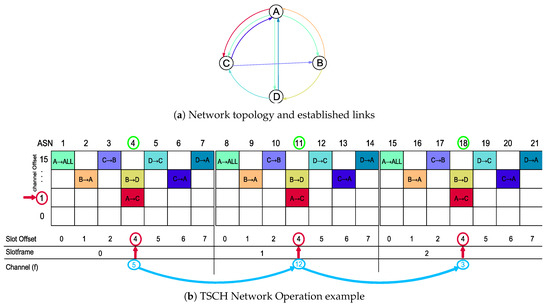
Figure 1.
Network topology and established links (a) and TSCH Network Operation example (b). The 1st timeslot is dedicated to broadcast data: A → ALL, while on the following timeslots only unicast transmissions/receptions are performed. The slotframe contains 7 timeslots and 3 cycles are shown. The frequency is obtained from (1).
A sensor node is then able to join a TSCH network after successfully receiving an Enhanced Beacon frame containing the following set of information: (i) the timeslot duration; (ii) the number of timeslots in a slotframe; (iii) synchronization-related data; (iv) the channel hopping sequence [6]. Each TSCH timeslot can be of six different types; namely [23]: TxDataRxAck (unicast transmission), TxData (broadcast transmission), RxDataTxAck (unicast reception), RxData (broadcast reception), Idle (indefinitely waiting for a frame) and Sleep (sleep mode).
Figure 2 illustrates the unicast communication process by illustrating the TxDataRxAck ↔ RxDataTxAck transaction.
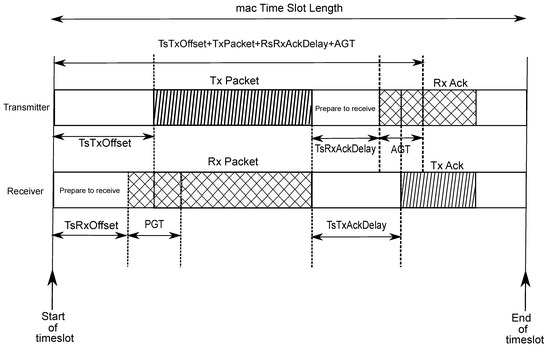
Figure 2.
Timeslot template for a TxDataRxAck ↔ RxDataTxAck transaction. (Adapted from [6]).
In the aforementioned transaction, the receiver initially waits the time period TsRxOffset and then turns its radio on. The upcoming phase is the Packet Guard Time (PGT), which lasts for a predefined amount of time, and has the purpose of encompassing possible synchronization issues. Note that the definition of PGT establishes a trade-off between error probability (which is reduced for large values of PGT) and energy consumption (which increases for large values of PGT). In case a frame does not arrive within the PGT period, the device goes to the sleep mode for the remainder of the timeslot. However, if a valid packet is received, the node waits TsTxAckDelay after receiving the last byte of the frame, and then becomes active to send an Acknowledgment (ACK) message to the transmitter.
The transmitter node, in turn, initially expends TsTxOffset preparing the data to be transmitted and properly configuring the radio parameters. After that, the radio switches on and starts sending the packet. After the transmission, there is a period of TsRxAckDelay where the transmitter is preparing to receive the ACK from the receiver node. Due to potential synchronization errors, there is also a transmitter-side Acknowledgment Guard Time (AGT), where the transmitter keeps waiting for the incoming ACK.
Usually, due to interference and consumption concerns, sensor nodes in WSNs operate under low duty-cycle policies, typically lower than [23,26]. Thus, one could expect the devices to frequently be either in the Sleep or the Idle modes. As a result, regardless the fact that the power employed in Sleep/Idle modes is considerable lower than that in the active modes, the large amount of time spent in such states leads to an energy consumption that cannot be neglected [23]. Moreover, since the receivers do not know exactly when the transmitter will send a packet, they are expected to keep their radios active during the entire RxDataTxAck and RxData windows upon being assigned to those states, awaiting the predetermined PGT guard time. Thus, it becomes important to model the influence of PGT on both energy consumption and reliability, such that this parameter can be properly adjusted aiming at meeting the application requirements.
3. Energy Consumption Model
The availability of an analytical energy consumption model is an important feature that can guide network designers to properly define and adjust the network parameters, subjected to the application requirements. In a practical WSN implementation, however, although the energy consumption is fundamentally dependent on the MCU and the radio consumptions, the overall consumption model varies depending on the platform in use. In this sense, even though recent works have modeled the energy consumption of a TSCH-based network [22,23], their proposed models are valid to the OpenWSN OS only, not accurately estimating the consumption of a Contiki OS TSCH implementation running on a CC2650 hardware platform, as will be seen in the results presented in Section 4.
It becomes then important to evaluate the energy consumption of a Contiki OS-based TSCH network, since it is widely adopted in the WSNs scope [5,24].
3.1. Energy Consumption of a CC2650 Running Contiki OS
Contiki OS has a TSCH and 6TiSCH implementation [5], a full low-power IP networking (6LoWPAN, RPL, CoAP and MQTT) and tools for software-based energy estimation, namely Energest and Powertrace [25]. Energest tracks the time the hardware components become active, such as radio or MCU, and Powertrace is responsible for reporting those values. Upon having knowledge about the power consumption of each component, one can then estimate the overall device energy consumption.
Aiming at obtaining an analytical model for the power consumption, one needs to assess the timing of each hardware component for every of slot. We then develop a General Purpose Input/Output (GPIO) state logic inside the TSCH DEBUG Macros from the Contiki TSCH implementation, which can be tracked by connecting a logic analyzer to the CC2650 (see Figure 3).
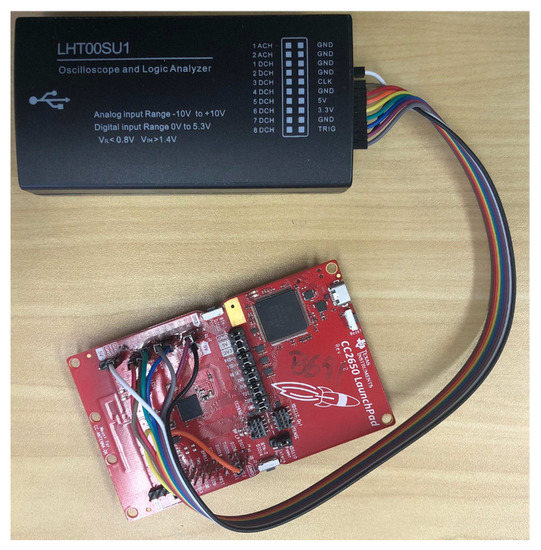
Figure 3.
CC2650 Launchpad connected to the Logic Analyzer.
The set of all the possible logic states is shown in Table 1. Note that each has an associated number, which is equivalent to the binary number represented by the output pins.

Table 1.
Set : Debug Logic States.
We also define the set of slot types as , such that the average power consumption for a given is calculated as
where is the set of consumption modes, represents the total time of a TSCH time slot and corresponds to the energy consumed for a given and slot , being calculated as
where V is the input voltage, is the current drawn at each and is the time spent at each for a given and pair. Note that a given does not necessarily have all the states from neither necessarily operates under all the modes from . In this situation, is set to zero.
Considering that represents the type whose t-th time slot has been assigned to, one can calculate the average power consumption for each as
where Q is the total number of time slots.
Figure 4 illustrates the procedure adopted to measure the timing properties of a given , in this particular case a RxDataTxAck, which consists of computing the timing of each within the states belonging to that . Since there is a deviation between different measures of the same 3-tuple (,,) due to reasons, such as multiple code branches (i.e., different execution paths) and variable duration of an operation (e.g., waking up the radio), we performed several different measures per (,,) aiming at obtaining an average value.

Figure 4.
Example of a RxDataTxAck slot captured in the Logic Analyzer Software.
The average measured values for all the possible combinations of (,,) are presented in Table 2 and Table 3, always for . The sets of states within each is presented in Table 4, sorted in chronological order of occurrence.

Table 2.
Average active times in for reception slots.

Table 3.
Average active times in for transmission slots.

Table 4.
Sets of states within each .
It is worth mentioning that such values are significantly different from the values obtained in previous works. Such a difference is depicted in Figure 5, which compares the values measured in this work to the standard timeslot model defined by the IEEE 802.15.4e amendment, as previously shown in Figure 2. For instance, the event 0xA shows that the CPU becomes active before expected (at the end of the TsTxOffset period). Moreover, the receiver also becomes active far before the start of the PGT period, which leads to considerable differences in the overall energy consumption calculations.
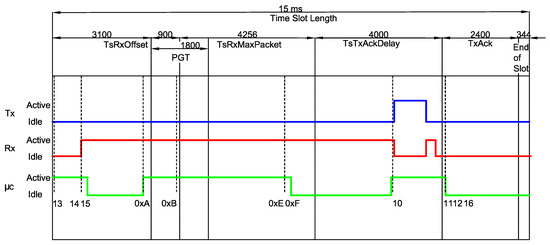
Figure 5.
A RxDataTxAck for . The timing of each within a can now be computed and a comparison between the standard timeslot model defined by the IEEE 802.15.4e and the measured timing is shown.
As mentioned in Section 1, the nodes need to send (TxData) and receive (RxData) EBs periodically in order to maintain synchronism. Increasing the Guard Time leads to higher energy consumption, since it requires the receiver to be active for a longer period. Usually the receiver and transmitter power consumptions are nearly on the same order [4], being then appropriate to turn off the radio whenever possible. However, the probability of losing an EB increases when the Guard Time is reduced. In practice, depending on the clock drift and the EB interval, there is a lower bound for the Guard Time, such that reducing this bound even further would bring benefits from the energy efficiency’s perspective.
3.2. The Guard Beacon Strategy
Aiming at reducing the Guard Time without compromising the synchronization, the so-called Guard Beacon scheme was proposed [9]. This strategy consists of sending a burst of several beacons instead of just a single beacon. The optimal number of beacons is shown to be [9]
where the nearest integer rounding function, , is the beacon interval, is the estimated deviation of clock drift rate, is the estimated deviation of message delivery delay, is the estimated deviation of clock offset, is the power consumption for idle listening, is the beacon duration and is the power consumption for data transmission.
The sending time of the nth beacon, with , is given by [9]
where corresponds to the inverse error function.
According to [9], the GB strategy can reduce the synchronization power consumption by ~40%. This motivates us to implement such a strategy over the TSCH beaconing system [27]. Since the beacons required by GB do not carry any additional payload, our implementation considers the use of only two bytes per beacon: one to identify the frame as a beacon and the second one to carry the beacon number.
However, due to setup-related issues, in our implementation the number of adopted beacons is fixed and equal to 3 GBs (Even though the time spent to send one byte is 32 , the radio API only returns from a transmission after ~500 . Since the standard Guard Time for a 15 timeslot is 1800 , the number of beacons is then upper limited to 3 GBs). Although this number does not necessarily represent the optimal number of GB from (5), we will show in Section 4 that it provides significant energy savings when compared to the Single Beacon strategy.
Another particularity of our proposal is to anticipate the transmission of the first GB, in order to increase the probability that at least one out of the three GBs is received by all the (multiple) nodes of the network. The idea behind this proposal comes from fact that the clock drifts of a dense network may occur in opposite directions (i.e., ppm for a node and ppm for another node with respect to the network clock source, for instance). Figure 6 illustrates the GB implementation.
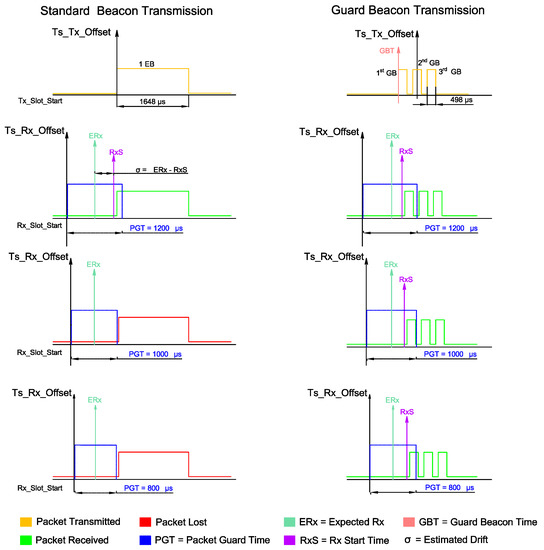
Figure 6.
GB Strategy Transmission detailed. The 1st GB is sent prior to TsTxOffset by a Guard Beacon Time (GBT) amount of time. The receiver has an increased probability of receiving one of the GBs even when PGT is small. The estimated drift is calculated as the difference between the Expected Rx Time (ERx) and the Rx Start Time (RxS) so that the receiver can synchronize itself.
Similarly to Section 3.1, we compute the timing for each within a for the types belonging to the GB-based set of types . The results are also presented in Table 2 and Table 3. Thus, the global average power consumption of a TSCH Network with the Guard Beacon strategy can be calculated with the sum of (4) for every and every . It is worth mentioning that, if a platform different from the CC2650 running the Contiki OS is considered, the only adaptation needed is a new measurement campaign, in order to obtain the values from Table 2 and Table 3 for the new hardware.
Additionally, in Figure 7 and Figure 8, a comparison between the standard timeslot model defined by the IEEE 802.15.4e and the measured timing is shown for TxGB and RxGB slots, respectively.
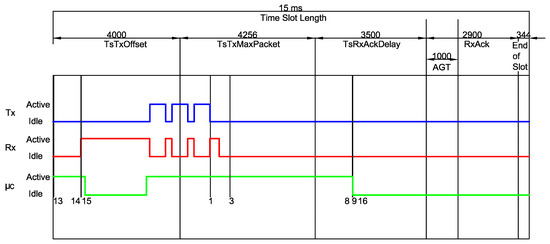
Figure 7.
A TxGB slot for . As in Figure 5, the timing of each within a is computed and a comparison between the standard IEEE 802.15.4e timeslot model and the measured timing is shown.
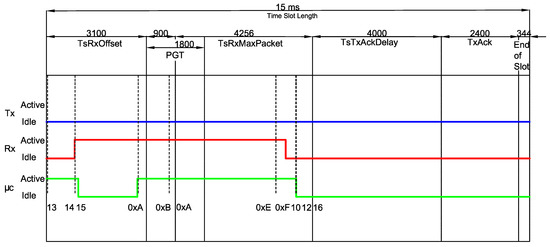
Regarding the scalability of our proposal, the effect of increasing the number of nodes can be neglected for the following reasons: (i) the frequency of Enhanced Beacons is the same for our scheme and the standard TSCH implementation. The difference is that instead of sending one EB we send three GBs on the same timeslot. Thus, our scheme is as scalable as the standard TSCH implementation; (ii) despite an increase in the network traffic, the energy consumption model would not be affected by increasing the number of nodes. Note that the energy consumption model takes into account the number of received and transmitted frames, such that it remains valid regardless the number of nodes.
After closely investigating the outcomes of the entire set of modes and slot types, we realize that an analytical model based solely on the IEEE 802.15.4e standard does not encompass some unexpected behaviors, such as:
- In a TxData or TxDataRxAck slot, the radio was supposed to enter in a sleep mode after finishing the packet transmission; however, it remains active for approximately an additional period of ;
- Although there is no incoming Ack in a TxData slot, the receiver remains active for about ;
- Upon receiving a packet, the receiver unnecessarily remains active for extra ~ in a RxData slot, regardless of the size of the received packet;
- The CPU remains active after the end of the timeslot for approximately in the TxDataRxAck timeslot and about for RxDataTxAck.
Thus, incorporating such odd behaviors into our energy consumption model plays an important role towards improving its accuracy, as we show in Section 4.
4. Performance Evaluation
This section presents some analytical and experimental results obtained from a 2-node Contiki TSCH Network using Texas Instruments CC2650 Launchpads. The simulation parameters are given in Table 5.

Table 5.
Simulation Parameters (Radio CC2650 and CPU ARM® Cortex®-M3).
The two-node network generates a log with information regarding the TSCH operation, which gives us information about the total number of timeslots, and the number of slots of each , which can be used to calculate the analytical global average power consumption from (4). The log also contains the Contiki’s Powertrace and Energest tools’ data, so that one can calculate the numerical global average power consumption. In what follows, two different scenarios are evaluated: the first one without the GB strategy while varying the EB period (); the second one with the Guard Beacon strategy with the same range of EB Periods.
The global average power consumptions for the two aforementioned scenarios while considering different EB transmission periods and the minimum achievable guard times are shown in Figure 9. As expected, it can be seen that the GB strategy improves the energy efficiency for all the EB transmission periods, since it can operate at lower guard times when compared to the standard Contiki’s TSCH implementation. On the right axis, the amount of extra power spent by the standard TSCH implementation is shown. For instance, when s and the GB strategy is not in use, more power is needed.

Figure 9.
Average power consumption as a function of the EB transmission periods for the GB-disabled and GB-enabled scenarios, while considering the minimum achievable guard times. The right axis shows the amount of extra power spent by the standard TSCH implementation.
Figure 10 shows the detailed average power consumption of for . The consumptions for the are barely visible in this scale, so that we opt for omitting their legend. As one could expect from inspecting Figure 9 for , the lowest possible power consumption occurs for the GB enabled scenario, with a Guard Time of 1000 . For a GB disabled scenario the most energy efficient scenario for the same occurs at , while consuming % more power than when the GB technique is in use. It can be seen that for the same guard times, both strategies have roughly the same CPU, Rx and overall power consumption. Again, the key factor that improves the energy efficiency is the lower guard times achieved by the GB enabled scenario.
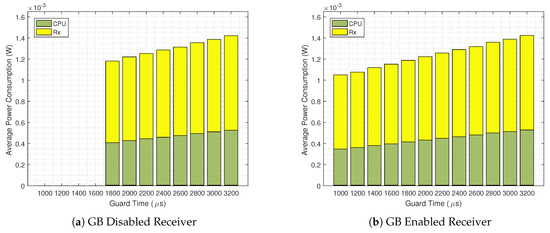
Figure 10.
Detailed average power consumption for GB disabled (a) and GB enabled scenarios (b) for .
The same analysis is shown in Figure 11, for , where the standard TSCH implementation consumes % more energy than the GB enabled scenario. Moreover, as seen in Figure 9 for , with the GB technique the system can operate with a 400 guard time, which results in an average power consumption of less than 1 , the most energy efficient among all the analyzed scenarios.
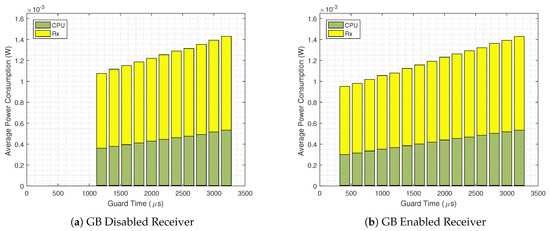
Figure 11.
Detailed average power consumption for GB disabled (a) and GB enabled scenarios (b) for .
Now, aiming at evaluating the accuracy of our analytical energy consumption model, we compare it with practical results. In Figure 12 we present the detailed average power consumption of for without the GB strategy implemented. It can be seen that there is a good match; however, the calculated overall power consumption is lower than the results obtained from the Contiki Powertrace tool. The same analysis is done in Figure 13, now with the GB technique in use. Again we see a good match, but with lower power consumption values obtained from the analytical equations.
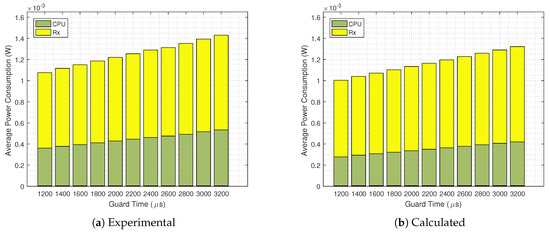
Figure 12.
Experimental (a) and calculated (b) average power consumption for a GB disabled and scenario.
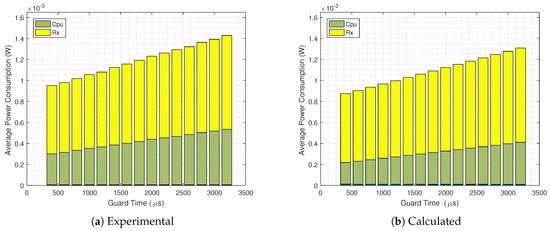
Figure 13.
Experimental (a) and calculated (b) average power consumption for a GB enabled and scenario.
In order to investigate the differences from Figure 12 and Figure 13, the analytical and practical results of every for are presented in Figure 14, for both Guard Beacon-enabled and disabled scenarios. We can draw some conclusions:
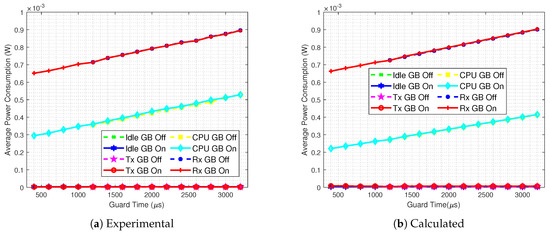
Figure 14.
Experimental (a) and calculated (b) detailed average power consumption comparison between GB enabled and GB disabled scenarios, for
- When the Guard Beacon strategy is implemented, energy savings can be achieved by considerably reducing the guard time;
- The difference between experimental and analytical values is mainly due to the CPU power consumption, since the analytical model does not encompass the CPU states outside the TSCH code.
Finally, in order to illustrate the energy savings, in Figure 15 we plot the lifetime of a TSCH-based CC2650 Launchpad platform, powered by a 3000 3 battery, for both GB enabled and GB disabled strategies. The same guard time interval is considered. It can be seen that, to the left of the dashed vertical line, only the GB enabled nodes can operate. Thus, the GB strategy can improve the lifetime by , which means that a node would operate up to 48 days more when compared to a TSCH node that does not employs the GB scheme.
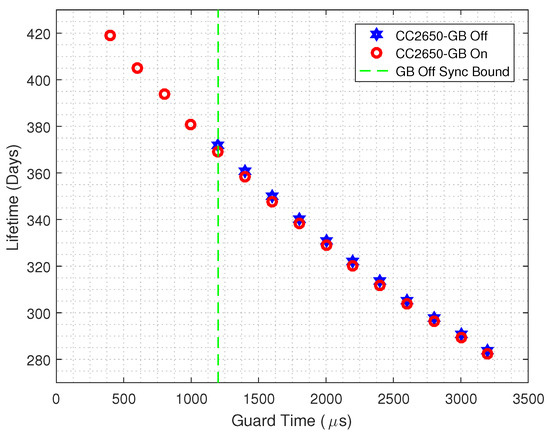
Figure 15.
Estimated Lifetime comparison for the CC2650 Launchpad when considering both GB enabled and GB disabled scenarios and a 3000 3 battery.
5. Conclusions
In this work we proposed a guard time reduction for the Contiki OS TSCH implementation by employing the Guard Beacon strategy. Additionally, an analytical model for the nodes’ power consumption was derived. We compared the results obtained from the analytical equations and from the Contiki Powertrace tool, which supported the proposed model. Although the equations cannot predict the CPU power consumption outside the TSCH code, it was shown that the model has great accuracy for all the analyzed scenarios. The GB strategy improved the TSCH energy efficiency, since the power consumptions of each for GB On and Off scenarios are almost the same, but a guard time reduction up to is provided, so that without the strategy the nodes would consume up to more power. In terms of battery lifetime, the Guard Beacon approach provided a 48 days extension when considering a 3000 3 battery, or improvement on the lifetime.
As future work, the impact of the Guard Beacon strategy on the TSCH rendezvous process can be assessed, aiming at reducing the network joining time, which could lead to important energy savings. Additionally, the Guard Beacon strategy could be added to the schemes proposed in [8,14], increasing the energy efficiency even further. Moreover, multi-hop TSCH networks could benefit both from the schemes proposed in [11,13] and the Guard Beacon strategy, so that even lower guard times could be achieved, as well as lower EB sending rates.
Author Contributions
Investigation, M.A.S.; Writing—review & editing, O.K.R., G.L.M. and J.L.R. All authors have read and agreed to the published version of the manuscript.
Funding
This research was partially funded by National Council for Scientific and Technological Development (CNPq, Brazil) grant number 305052/2017-9.
Conflicts of Interest
The authors declare no conflict of interest.
References
- Ren, J.; Zhang, Y.; Zhang, K.; Liu, A.; Chen, J.; Shen, X.S. Lifetime and Energy Hole Evolution Analysis in Data-Gathering Wireless Sensor Networks. IEEE Trans. Ind. Informat. 2016, 12, 788–800. [Google Scholar] [CrossRef]
- Yetgin, H.; Cheung, K.T.K.; El-Hajjar, M.; Hanzo, L.H. A Survey of Network Lifetime Maximization Techniques in Wireless Sensor Networks. IEEE Commun. Surveys Tuts. 2017, 19, 828–854. [Google Scholar] [CrossRef]
- Youssef, M.F.; Elsayed, K.M.F.; Zahran, A.H. Contiki-AMAC–The enhanced adaptive radio duty cycling protocol: Proposal and analysis. In Proceedings of the 2016 Int. Conf. on Sel. Topics in Mobile Wireless Netw. (MoWNeT), Cairo, Egypt, 11–13 April 2016; pp. 1–6. [Google Scholar] [CrossRef]
- Texas Instruments. CC2650 SimpleLink™ Multistandard Wireless MCU. Available online: https://www.ti.com/lit/ds/symlink/cc2650.pdf (accessed on 23 October 2020).
- Duquennoy, S.; Elsts, A.; Nahas, B.A.; Oikonomou, G. TSCH and 6TiSCH for Contiki: Challenges, Design and Evaluation. In Proceedings of the 2017 13th International Conference on Distributed Computing in Sensor Systems (DCOSS), Ottawa, ON, Canada, 5–7 June 2017; pp. 11–18. [Google Scholar] [CrossRef]
- IEEE. IEEE Standard for Low-Rate Wireless Personal Area Networks (LRWPANs). Available online: https://standards.ieee.org/standard/802_15_4-2015.html (accessed on 23 October 2020).
- Djenouri, D.; Bagaa, M. Synchronization Protocols and Implementation Issues in Wireless Sensor Networks: A Review. IEEE Syst. J. 2016, 10, 617–627. [Google Scholar] [CrossRef]
- Vera-Pérez, J.; Todolí-Ferrandis, D.; Santonja-Climent, S.; Silvestre-Blanes, J.; Sempere-Payá, V. A Joining Procedure and Synchronization for TSCH-RPL Wireless Sensor Networks. Sensors 2018, 18, 3556. [Google Scholar] [CrossRef] [PubMed]
- Chen, Y.; Qin, F.; Yi, W. Guard Beacon: An Energy-Efficient Beacon Strategy for Time Synchronization in Wireless Sensor Networks. IEEE Commun. Lett. 2014, 18, 987–990. [Google Scholar] [CrossRef]
- Mavromatis, A.; Papadopoulos, G.Z.; Fafoutis, X.; Elsts, A.; Oikonomou, G.; Tryfonas, T. Impact of Guard Time Length on IEEE 802.15.4e TSCH Energy Consumption. In Proceedings of the 2016 13th Annual IEEE International Conference on Sensing, Communication and Networking (SECON), London, UK, 27–30 June 2016; pp. 1–3. [Google Scholar] [CrossRef]
- Papadopoulos, G.Z.; Mavromatis, A.; Fafoutis, X.; Montavont, N.; Piechocki, R.; Tryfonas, T.; Oikonomou, G. Guard time optimisation and adaptation for energy efficient multi-hop TSCH networks. In Proceedings of the 2016 IEEE 3rd World Forum on Internet of Things (WF-IoT), Reston, VA, USA, 12–14 December 2016; pp. 301–306. [Google Scholar] [CrossRef]
- Papadopoulos, G.; Mavromatis, A.; Fafoutis, X.; Piechocki, R.; Tryfonas, T.; Oikonomou, G. Guard Time Optimisation for Energy Efficiency in IEEE 802.15.4-2015 TSCH Links. In Proceedings of the EAI International Conference on Interoperability, Safety and Security in IoT. 2nd InterIoT 2016 and 3rd SaSeIoT 2016, Paris, France, 26–27 October 2016; pp. 56–63. [Google Scholar] [CrossRef]
- Mavromatis, A.; Papadopoulos, G.Z.; Elsts, A.; Montavont, N.; Piechocki, R.; Tryfonas, T.; Oikonomou, G.; Fafoutis, X. Adaptive Guard Time for Energy-Efficient IEEE 802.15.4 TSCH Networks. In Proceedings of the 17th IFIP WG 6.2 International Conference on Wired/Wireless Internet Communication (WWIC), Bologna, Italy, 17–18 June 2019; pp. 15–26. [Google Scholar] [CrossRef]
- Vera-Pérez, J.; Todolí-Ferrandis, D.; Silvestre-Blanes, J.; Sempere-Payá, V. Bell-X, An Opportunistic Time Synchronization Mechanism for Scheduled Wireless Sensor Networks. Sensors 2019, 19, 4128. [Google Scholar] [CrossRef] [PubMed]
- Karalis, A.; Zorbas, D.; Douligeris, C. Collision-Free Advertisement Scheduling for IEEE 802.15.4-TSCH Networks. Sensors 2019, 19, 1789. [Google Scholar] [CrossRef] [PubMed]
- Papadopoulos, G.Z.; Fafoutis, X.; Thubert, P. Multi-Source Time Synchronization in IEEE Std 802.15.4-2015 TSCH Networks. Internet Technol. Lett. 2020, 3, 148. [Google Scholar] [CrossRef]
- Dunkels, A.; Gronvall, B.; Voigt, T. Contiki-a lightweight and flexible operating system for tiny networked sensors. In Proceedings of the 29th Annual IEEE International Conference on Local Computer Networks (LCN), Tampa, FL, USA, 16–18 November 2004; pp. 455–462. [Google Scholar] [CrossRef]
- Levis, P. TinyOS: An Operating System for Sensor Networks. In Ambient Intelligence; Weber, W., Rabaey, J.M., Aarts, E., Eds.; Springer: Berlin, Germany, 2005; pp. 115–148. [Google Scholar] [CrossRef]
- Baccelli, E.; Hahm, O.; Gunes, M.; Wahlisch, M.; Schmidt, T.C. RIOT OS: Towards an OS for the Internet of Things. In Proceedings of the 2013 IEEE Conference on Computer Communication Workshops (INFOCOM WKSHPS), Turin, Italy, 14–19 April 2013; pp. 79–80. [Google Scholar] [CrossRef]
- Watteyne, T.; Vilajosana, X.; Kerkez, B.; Chraim, F.; Weekly, K.; Wang, Q.; Glaser, S.; Pister, K. OpenWSN: A standards-based low-power wireless development environment. Trans. Emerging Tel. Tech. 2012, 23, 480–493. [Google Scholar] [CrossRef]
- The Zephyr Project. An RTOS for IoT. Available online: http://www.zephyrproject.org (accessed on 23 October 2020).
- Daneels, G.; Municio, E.; Van de Velde, B.; Ergeerts, G.; Weyn, M.; Latré, S.; Famaey, J. Accurate Energy Consumption Modeling of IEEE 802.15.4e TSCH Using Dual-Band OpenMote Hardware. Sensors 2018, 18, 437. [Google Scholar] [CrossRef] [PubMed]
- Vilajosana, X.; Wang, Q.; Chraim, F.; Watteyne, T.; Chang, T.; Pister, K.S.J. A Realistic Energy Consumption Model for TSCH Networks. IEEE Sens. J. 2014, 14, 482–489. [Google Scholar] [CrossRef]
- Dunkels, A. Contiki, the open source OS for the Internet of Things. Available online: https://github.com/contiki-os/contiki (accessed on 23 October 2020).
- Dunkels, A.; Eriksson, J.; Finne, N.; Tsiftes, N. Powertrace: Network-level Power Profiling for Low-power Wireless Networks. Available online: http://soda.swedishict.se/4112/ (accessed on 23 October 2020).
- Kovatsch, M.; Duquennoy, S.; Dunkels, A. A Low-Power CoAP for Contiki. In Proceedings of the 2011 IEEE 8th International Conference on Mobile Ad-Hoc and Sensor Syst. (MASS), Valencia, Spain, 17–22 October 2011; pp. 855–860. [Google Scholar] [CrossRef]
- Rayel, O.K.; de Sordi, M.A. Contiki’s TSCH Guard Beacon Implementation. Available online: https://zenodo.org/record/3268707 (accessed on 23 October 2020).
Publisher’s Note: MDPI stays neutral with regard to jurisdictional claims in published maps and institutional affiliations. |
© 2020 by the authors. Licensee MDPI, Basel, Switzerland. This article is an open access article distributed under the terms and conditions of the Creative Commons Attribution (CC BY) license (http://creativecommons.org/licenses/by/4.0/).